Walachei |
|
|
|
| Übersicht – Contents: | |
Walachei |
|
|
|
| Übersicht – Contents: | |
Flaggen – Flags: |
|
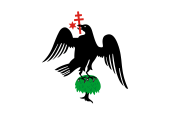 |
14.–15. Jhd./century, |
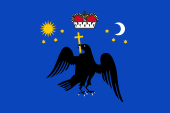 |
18./19. Jhd./century, |
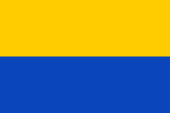 |
19. Jhd./century, |
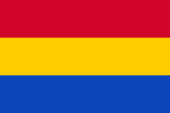 |
ca. 1843–1861, |
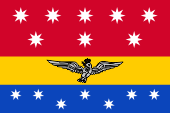 |
ca. 1843–1861, |
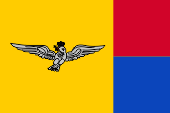 |
ca. 1843–1861, |
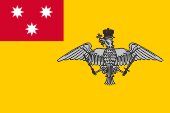 |
ca. 1843–1861, |
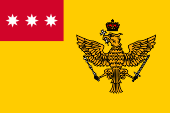 |
ca. 1843–1861, |
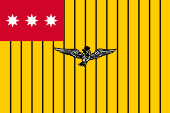 |
ca. 1843–1861, |
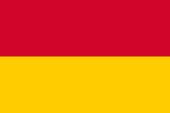 |
19. Jhd./century, |
| Das Wappen des Landes zeigt einen schwarzen Raben auf Blau. Normalerweise hätten die Flaggen des Landes zunächst dieses Bild zeigen sollen. Quellen aus dem 14. und 15. Jahrhundert berichten jedoch, dass es zunächst weiße Flaggen mit dem schwarzen Raben gegeben habe. Was das für Gründe hatte, ist unbekannt. In späteren Quellen des 18. und vom Anfang des 19. Jahrhunderts werden blaue Flaggen mit dem schwarzen Raben beschrieben, der sich allmählich zu einem Adler umwandelte oder gar als Mischwesen auftauchte. In der ersten Hälfte des 19. Jahrhunderts verlieh Sultan Mahmud II. den Walachischen Truppen gelb-blaue Wimpel, so dass diese Farben als Landesfarben angenommen werden können. Ab etwa 1843 scheint die Farbe Rot in den Kreis der Landesfarben aufgenommen worden zu sein (aus welchem Anlass ist unbekannt), denn diese drei Farben finden sich auf Truppenfahnen, der Marineflagge und auch der Kriegsflagge. Die Nationalflagge ist rätselhaft, denn es scheinen verschiedene Versionen überliefert. Übereinstimmend wird die gelbe Flagge mit der roten Oberecke und den drei Sternen genannt, ähnlich dem Modell des Fürstentums Moldau, jedoch ist die Abbildung des Adlers sehr verschieden. Schriftlich überliefert ist der Adler in hellblau (das würde einigermaßen zu den Landesfarben passen), scheint aber als silbern wahrgenommen worden zu sein und in der Praxis sogar golden oder naturfarben im Einsatz gewesen zu sein, obwohl die Heraldik Silber und Gold verbieten würde und erst recht Gold auf Gold. Auch eine angebliche Handelsflagge wird gemeldet, mit 15 senkrechten Streifen über die Grundfläche der gelben Flagge, was in der Praxis, auf Grund der Schwierigkeiten in der Herstellung einer solchen Flagge, gar nicht vorstellbar ist. Immerhin zeigen alle diese Varianten lediglich Rot und Gelb, so dass einige Quellen auch Rot und Gelb als die Landesfarben der Walachei angeben, eine grobe Abweichung von den Farben des Wappens und sehr zweifelhaft. Das ist immer dann von Bedeutung, wenn es um den Ursprung der Farben der rumänischen Flagge geht. Die rumänischen Farben Blau, Gelb und Rot entstanden während der Revolution der Jahre 1848/1849 durch die Kombination der Farben des Fürstentums Walachei und des Fürstentums Moldau, nämlich Gelb/Blau und Rot/Blau. Es hat aber eher den Anschein, das Blau, Gelb und Rot schon vorher in der Walachei verwendet wurden, und auch der offizielle Name des Fürstentums Walachei "Principatul Tării Românesti" zeigte schon die Verwendung des Therms "Rumänisch". Wie auch immer, im Jahre 1861 entstand der Staat Rumänien durch die Vereinigung dieser beiden Fürstentümer. |
The coat of arms of the
country shows a black raven on blue. Normally, the country's flags should
have initially shown this image. However, sources from the 14th and 15th
centuries report that there were initially white flags with the black raven.
What the reasons for this were is unknown. Later sources from the 18th and the beginning of the 19th century describe blue flags with the black raven, which gradually changed to an eagle or even appeared as a hybrid. In the first half of the 19th century, Sultan Mahmud II granted yellow-blue pennants to Wallachian troops, so these colours can be assumed to be the national colours. From about 1843, the colour red seems to have been included in the circle of national colours (for what reason is unknown), because these three colours are found on troop flags, the naval flag and also the war flag. The national flag is puzzling, as various versions seem to have survived. The yellow flag with the red upper corner and the three stars, similar to the model of the Principality of Moldova, is mentioned in agreement, but the depiction of the eagle is very different. The eagle has been handed down in writing in light blue (which would fit the national colours to some extent), but seems to have been perceived as silver and in practice even gold or natural-coloured in use, although heraldry would forbid silver and gold and even more so gold on gold. An alleged merchant flag is also reported, with 15 vertical stripes across the base of the yellow flag, which in practice, due to the difficulties in producing such a flag, is not even conceivable. After all, all these variants show only red and yellow, so that some sources also state red and yellow as the national colours of Wallachia, a potent deviation from the colours of the coat of arms and very doubtful. This is always significant when it is asked for the origin of the colours of the Romanian flag. The Romanian colours blue, yellow and red were created during the revolution of 1848/1849 by combining the colours of the Principality of Wallachia and the Principality of Moldavia, namely yellow/blue and red/blue. However, it seems that blue, yellow and red had already been used in Wallachia, and the official name of the Principality of Wallachia "Principatul Tării Românesti" also showed the use of the Romanian term. However, in 1861, the state of Romania was created by the union of these two principalities. |
| Quelle/Source: Flags of the World, Flaggen und Wappen der Welt, Die Welt der Flaggen, Wikipedia (EN), Volker Preuß | |
Wappen – Coat of Arms: |
|
 |
Wappen der Walachei – coat of arms of Wallachia, Quelle/Source, nach/by: Flags of the World |
|
|
|
| Das Wappen des Landes zeigte einen schwarzen, auffliegenden Raben auf Blau, auf einem Wacholderbusch, der ein goldenes Kreuz im Schnabel hält. Links und rechts des Kopfes erscheinen die Sonne und der Mond. Der schwarze Rabe wandelte sich allmählich, über die Jahrhunderte zu einem Adler, oder wurde gar als Mischwesen dargestellt. Der spätere Adler der Walachei dominiert bis heute die Heraldik ganz Rumäniens. |
The coat of arms of the
country showed a black soaring raven on blue, on a juniper bush, holding a
golden cross in its beak. To the left and right of the head appear the sun
and the moon. The black raven gradually changed, over the centuries, into an eagle, or was even depicted as a hybrid creature. The later eagle of Wallachia dominates the heraldry of all Romania to this day. |
| Quelle/Source: Flags of the World, Volker Preuß | |
| interaktive Landkarte – interactive Map: |
| Die historischen Regionen in Rumänien – The historical Regions in Romania |
|
|
|
| Zahlen und Fakten – Numbers and Facts: | |
|
|
|
|
|
|
|
|
|
|
|
|
|
ca. 2000 v.Chr. · Herausbildung des Volkes der Thraker in Dakien (heutiges
Siebenbürgen) 7. Jahrhundert v.Chr. · Gründung griechischer Kolonien an der Küste des Schwarzen Meeres 70–44 v.Chr. · legendäre Herrschaft des thrakischen Königs Burebista 106 · der Römische Kaiser und Heerführer Trajan erobert Dakien, Eingliederung als Provinz Dacia 4. bis 6. Jahrhundert · Völkerwanderung, durch die Ausbreitung der Hunnen in Mittelasien werden ganze Völkerschaften nach Westen gedrängt, die Hunnen schieben die Slawen vor sich her, und diese die Germanen, die Germanen weichen auf das Gebiet des Römischen Reichs aus 270 · die römischen Truppen ziehen sich aus Dakien zurück 271/272 · der Römische Kaiser Aurelian überlässt Dakien offiziell den Westgoten 441 · die Hunnen durchziehen Dakien und unterwerfen es 453 · Tod des Hunnenkönigs Attila 454 · Abzug der Hunnen 6. Jahrhundert · Einwanderung von Slawen 7. Jahrhundert · aus den verbliebenen Dako-Römern entsteht das Volk der Dako-Romanen 800 · Vernichtung des Awarenreichs durch Karl den Großen, Dakien wird zeitweilig von Bulgaren beherrscht 9. bis 13. Jahrhundert · Invasionen der Petschenegen, Kumanen und Tataren 13. Jahrhundert · ein Volk der Rumänen wird erstmals urkundlich erwähnt 1300–1330 · Vereinigung kleinerer rumänischer Fürstentümer (Oltenien, Muntenien ...) zum Fürstentum Walachei 1387 · Abhängigkeit von Polen-Litauen 1400 · erste türkische Angriffe die Walachei 1415 · das Fürstentum Walachei wird dem Osmanischen Reich (Türkei) tributpflichtig 1461 · Fürst Stephan der III. von Moldau (der Große, ca. 1435–1504) erwibt die Walachei 1475 · Aufstand des Fürstentums Moldau unter Fürst Stephan dem Großen, Sieg über die Türken, Wiederherstellung der Unabhängigkeit von Moldau und Walachei 1511 · die Walachei wird vom Osmanischen Reich unter beschränkter innerer Autonomie annektiert 1593 · Michael der Tapfere (Mihai Viteazul) wird Fürst der Walachei 1595 · Michael der Tapfere besiegt die Türken 1599 · Michael der Tapfere wird kurzzeitig Fürst von Siebenbürgen 1600 · Michael der Tapfere wird Fürst von Moldau 19.08.1601 · Michael der Tapfere wird ermordet, Walachei und Moldau müssen die türkische Oberhoheit endgültig anerkennen 1711 · die Türken besiegen die moldauisch-russischen Befreiungsarmeen, die Fürsten der Moldau und der Walachei werden abgesetzt und durch griechische Statthalter (Phanarioten) ersetzt 1716–1718 · Türkenkrieg 21.07.1718 · Friede von Passarowitz (Pozarevac), das Osmanische Reich tritt das Banat, die Kleine Walachei und Nordserbien an das Haus Habsburg ab 1739 · die Kleine Walachei und Nordserbien werden wieder an das Osmanische Reich übergeben ab 1774 · wieder Zunahme des russischen Einflusses 1821 · großer Anti-Türkischer Aufstand in der Walachei unter Tudor Vladimirescu, griechischer Nationalaufstand in Griechenland, die Phanariotenherrschaft wird durch das Osmanische Reich beendet 1828–1829 · Russisch-Türkischer Krieg, Niederlage der Türkei, Russland errichtet eine Art Protektorat über Moldau und Walachei, die türkische Oberhoheit bleibt jedoch bestehen 1848–1849 · bürgerlich-demokratische Revolution in der Walachei, der Fürst der Walachei tritt vorübergehend zurück, die Revolution wird durch türkische und russische Truppen niedergeschlagen 1856/58 · Krimkrieg, Pariser Verträge, das russische Protektorat wird zugunsten eines Protektorats von sieben Europäischen Staaten ersetzt 1859 · Oberst Alexandru Ioan Cuza wird zum Fürsten von Walachei und Moldau gewählt 1861 · Fürst Ioan Cuza proklamiert das Fürstentum Rumänien durch Vereinigung von Walachei und Moldau |
|
ca. 2000 B.C. · evolution of the nation of the Thrakians in Dakia (today’s
Siebenburgen) 7th century B.C. · foundation of greek colonies at the coast of the Black Sea 70–44 B.C. · legendary reign of the Thrakian King Burebista 106 · the Roman Emperor and General Trajan conquers Dakia, incorporation as Province of Dacia 4th to 6th century · Great Transmigration (Migration Period), because of the expansion of the Huns in the Middle Asia Region whole nations became pushed to west, the Huns push the Slavs and that the Teutonic tribes, the Germanic tribes switch over to the area of the Roman Empire 270 · the Roman troops retreat from Dacia 271/272 · the Roman Emperor Aurelian cedes Dacia officially to the Western Goth 441 · the Huns range Dacia and submit it 453 · death of Attila, the King of the Huns 454 · withdrawal of the Huns 6th century · immigration of Slavs 7th century · out of the remaining Dako-Romans arises the Nation of the Dako-Romanesques 800 · annihilation of the Empire of the Awares by Carl the Great, Dacia is temporary ruled by Bulgarians 9th to 13th century · invasions of the Petsheneges, Kumans and Tatars 13th century · ein Volk der Rumänen wird erstmals urkundlich erwähnt 1300–1330 · unification of smaller Romanian principalities (Oltenia, Muntenia ...) to the Principality of Wallachia 1387 · dependence from Poland-Lithuania 1400 · initial Turkish (Ottoman Empire) attacks against Wallachia 1415 · the Principality of Wallachia has to pay tribute to the Ottoman Empire (Turkey) 1461 · Prince Stephan III. of Moldavia (the Great, ca. 1435–1504) earns Wallachia 1475 · revolt of the Principality of Moldavia under Prince Stephan the Great, triumph over the Turks, restoration of the independence of Moldavia and Wallachia 1511 · Wallachia becomes annexed by the Ottoman Empire under limited interior autonomy 1593 · Michael the Brave (Mihai Viteazul) becomes Prince of Wallachia 1595 · Michael the Brave triumphs over the Turks 1599 · Michael the Brave becomes momentary Prince of Siebenburgen 1600 · Michael the Brave becomes Prince of Moldavia 19th of August 1601 · Michael the Brave becomes murdered, Wallachia and Moldavia have to recognize ultimately the Turkish supremacy 1711 · the Turks triumph over the Moldavian-Russian liberation armies, the Princes of Wallachia and Moldavia become dismissed and substituted by Greek proconsuls (Phanariots) 1716–1718 · Turk's War 21.07.1718 · Peace of Passarowitz (Pozarevac), the Ottoman Empire cedes the Banat, the Lesser Wallachia and Northern Serbia to the House of Habsburg 1739 · the Lesser Wallachia and Northern Serbia were handed over back to the Ottoman Empire since 1774 · again increase of the Russian influence 1821 · great Anti-Turkish revolt in Wallachia under Tudor Vladimirescu, greek national uprising in Greece, the rule of the Phanariots becomes terminated by the Ottoman Empire 1828–1829 · Russian-Turkish War, defeat of Turkey, Russia establishes a kind of a protectorate üver Moldavia and Wallachia, but the Turkish supremacy consist furtherly 1848–1849 · civil-democratic revolution in Wallachia, the Prince of Wallachia resigns momentarily, the revolution becomes suppressed by Turkish and Russian troops 1856/58 · Crimean War, Treaties of Paris, the Russian protectorate becomes substituted by a protectorate of seven European states 1859 · Colonel Alexandru Ioan Cuza becomes elected to the Prince of Wallachia and Moldavia 1861 · Prince Ioan Cuza proclaims the Principality of Romania by unification of Wallachia and Moldavia |
| Quelle/Source: Atlas zur Geschichte, Wikipedia (EN), World Statesmen, Pierer's Universal-Lexikon, 4. Auflage, 1857–1865 |
| Die Griechen nannten das Land "Vlachia", woher sich der Name des Landes ableitet. Die Bewohner nannten sich dagegen selbst "Român", also "Römer", ein Hinweis auf ihre Herkunft. Im benachbarten deutschen Sprachraum wurden die Bewohner des Landes zu "Walachen", was prägend für den Landesnamen im Ausland wurde. Die Walachen selbst nannten ihr Land "Muntenia", bei den Türken hieß es "Ak-Iflak". | The Greeks called the country "Vlachia", from which the name of the country is derived. The inhabitants, on the other hand, called themselves "Român", i.e. "Romans", a reference to their origin. In the neighbouring German-speaking area, the inhabitants of the country became "Wallachians", which became formative for the country's name abroad. The Wallachians themselves called their country "Muntenia", the Turks called it "Ak-Iflak". |
| Die Walachei besteht aus der Kleinen Walachei (Oltenien) westlich des Flusses Alt (Olt) und der Großen Walachei (Muntenien), östlich des Flusses Alt (Olt). | Wallachia consists in Lesser Wallachia (Oltenia) western the Alt River (Olt) and in Greater Wallachia (Muntenia), eastern the Alt River (Olt). |
| Quelle/Source: Wikipedia (DE), Volker Preuß | |